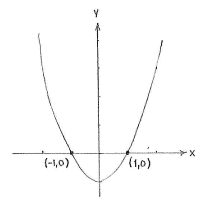Solution 2.3:9a
From Förberedande kurs i matematik 1
(Difference between revisions)
m (Lösning 2.3:9a moved to Solution 2.3:9a: Robot: moved page) |
|||
| Line 1: | Line 1: | ||
| - | {{ | + | A point lies on the |
| - | < | + | <math>x</math> |
| - | {{ | + | -axis if it has |
| + | <math>y</math> | ||
| + | -coordinate | ||
| + | <math>0</math> | ||
| + | and we therefore look for all the points on the curve | ||
| + | <math>y=x^{\text{2}}-\text{1}</math> | ||
| + | where | ||
| + | <math>y=0</math>, i.e. all points which satisfy the equation | ||
| + | |||
| + | |||
| + | <math>0=x^{\text{2}}-\text{1}</math> | ||
| + | |||
| + | |||
| + | This equation has solutions | ||
| + | <math>x=\pm \text{1}</math>, which means that the points of intersection are | ||
| + | <math>\left( -1 \right.,\left. 0 \right)</math> | ||
| + | and | ||
| + | <math>\left( 1 \right.,\left. 0 \right)</math>. | ||
| + | |||
| + | |||
[[Image:2_3_9_a.gif|center]] | [[Image:2_3_9_a.gif|center]] | ||
Revision as of 11:43, 21 September 2008
A point lies on the \displaystyle x -axis if it has \displaystyle y -coordinate \displaystyle 0 and we therefore look for all the points on the curve \displaystyle y=x^{\text{2}}-\text{1} where \displaystyle y=0, i.e. all points which satisfy the equation
\displaystyle 0=x^{\text{2}}-\text{1}
This equation has solutions
\displaystyle x=\pm \text{1}, which means that the points of intersection are
\displaystyle \left( -1 \right.,\left. 0 \right)
and
\displaystyle \left( 1 \right.,\left. 0 \right).

